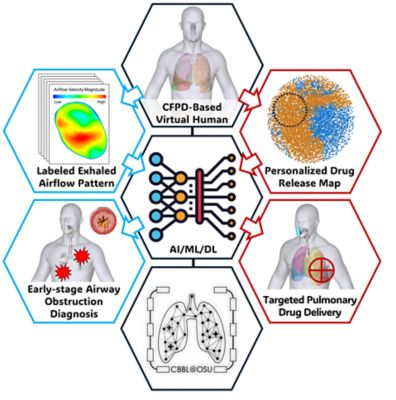Overview
Existing diagnostic and treatment methods for pulmonary diseases face challenges. Traditional diagnostic methods are often invasive and lack the precision to identify obstructions in small airways or detect subtle airway obstruction changes in the early stages of diseases like COPD. Conventional inhalation therapies struggle to deliver aerosolized medications effectively to targeted disease sites within the airways, frequently affecting healthy tissues and leading to suboptimal therapeutic outcomes and side effects.
Artificial Intelligence (AI) algorithms, particularly Machine Learning (ML) and Deep Learning (DL) techniques, present novel opportunities for enhancing diagnostic accuracy and personalizing treatment plans. These algorithms can analyze complex datasets and extract meaningful patterns, facilitating the development of innovative diagnostic methods and the strategic planning of targeted pulmonary drug delivery.
Furthermore, computational fluid dynamics (CFD) can significantly support these AI-driven advancements by generating reliable spatiotemporal distribution data on airflow and particle transport within the respiratory system. This high-fidelity simulation data is the foundation for training and testing AI model prototypes, ensuring their accuracy and applicability in clinical settings.
In this presentation, the integration of CFD and AI is exemplified in two research studies, i.e., (1) The first example focuses on using a combined CFD-AI approach to enable the noninvasive detection of airway obstructions, achieving early diagnosis with unprecedented precision for COPD patients. (2) The second example addresses the challenge of treating Juvenile Onset Recurrent Respiratory Papillomatosis (JORRP) by optimizing drug delivery to the larynx and glottis, showcasing the potential for AI to guide the development of smart inhalers that can achieve targeted drug delivery on a patient-specific level.
What you will learn
- How to model a patient-specific respiratory drug delivery model
- The value of combining AI/ML with CFD for diagnosis and treatment of respiratory diseases
- How to design a smart inhaler for personalized healthcare
- The emerging importance of respiratory system digital twin for diagnosis and treatment
Who should attend
Anyone in the pharmaceutical and biopharma industry is directly or remotely involved with drug delivery, including engineers, managers, directors, VPs, and even C-level executives related to process, production, safety, and regulatory activities.
Speakers
Yu Feng, Associate Professor, School of Chemical Engineering, Oklahoma State University
